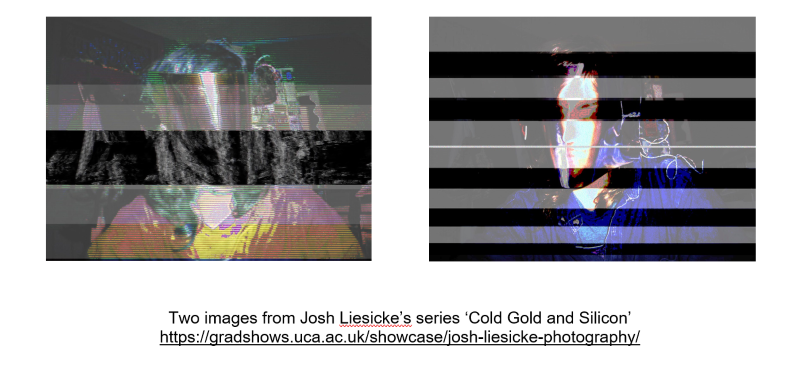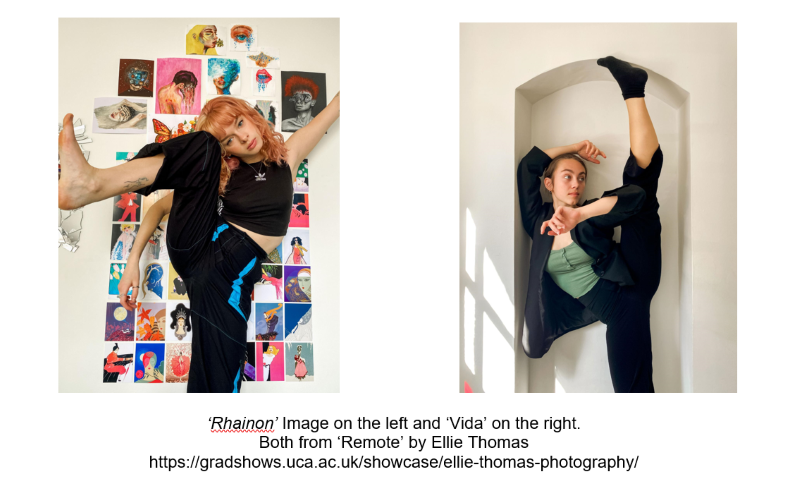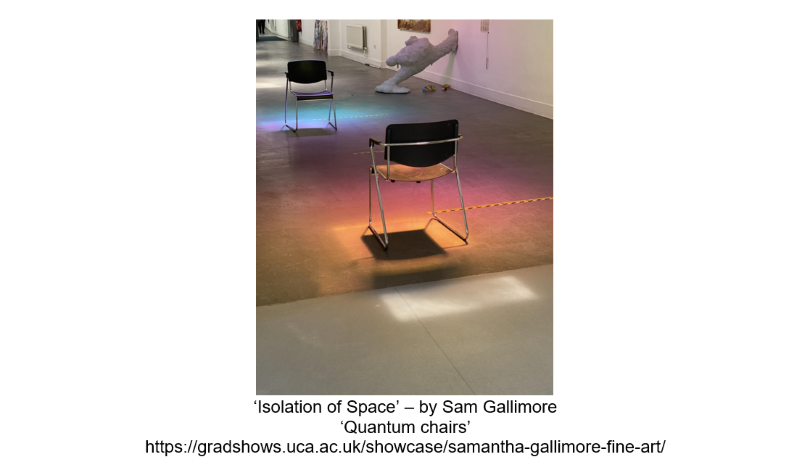Lockdown
from Isolation emerges Inspiration
This exhibition, curated by Zoe Storer on their graduate placement with the Galleries and Research Team, presents a range of art works taken from the 2021 University of the Creative Arts graduates show. These artworks were created for the graduate’s final year during the Covid-19 pandemic. Zoe wanted to explore how lockdown influenced the art and its creators.
Event details
-
1 October 2021 - 31 December 2021
10:00-17:00 (GMT)
Online
/prod01/channel_8/media/galleries/Screenshot-(296).png)
I would like to thank UCA and the following Post Graduates for giving permission for their works to be used in this exhibition:
Joshua Liesicke, Ellie Thomas, Sam Gallimore, Céline Ufenast and Saskia Hanssen
Catapulted into online learning, social distancing and isolation, did the graduates feel artistically restricted or was it the catalyst for new inspiration through adapting to their circumstances to shape their final works.
Through out the years, during a time of crisis art has thrived and has been an outlet for both artists and viewers. For example: the AIDS crisis in the 1980’s had artists from around the world create art not only as an outlet but as a form of awareness. Art is a universal language.
Keith Haring, Donald Moffett and many others during this time created works to spread awareness of the crisis.
One of UCA’s graduates is Josh Liesicke. Liesicke’s series ‘Cold Gold and Silicon’ is a sequence of digitally altered images that convey a message connected to the digital world and the impact it has had over the last year during the pandemic.
Josh told me;- “Originally Cold Gold & Silicon was created to express my frustration with having to reply on digital communication throughout the UK’s first national lockdown. This started by creating darkroom prints and scans of computer parts and wires. As the work progressed, it started to move in more of an exploration direction, and my attitude towards the subject shifted. While I was initially using the project as a way to cope with the anxieties and disconnects that come with forced online spaces, I later found it to be a comfort. It became another means of escape. I was creating, designing and owning my own digital world, to come to peace with my initial negative and difficult feelings.”
Liesicke’s series expresses the frustrations of using digital communication to socialise and communicate with our friends and family is something which the majority of us have experienced and can sympathise with. I find Liesicke’s work really interesting, transforming from negative expression to find peace in a self-expressive way to escape our current times. I love how this series shows the screen glitches and digital disruption, disconnecting and malfunctioning in this beautiful way. Mirroring the pause to normal life the pandemic created, the interruption in social interaction leading to misinterpretation.
Another artists is Ellie Thomas. Thomas’s final series ‘Remote’ was conducted remotely via an app during the pandemic.
Thomas wrote:- “Remote is a series of images of young dancers who have been forced to train within their homes due to lockdown. All the images where shot remotely via an app, allowing me to control the dancers phone camera. Each image was shot within the environment in which the dancers have had to carry out their rigorous training for months in lockdown, noting how each dancer interacts differently with their environment to examine their transition from the stage/studio to their rooms. Each environment portrait showcases the dancer’s skill, strength and resilience – highlighting their dedication to the craft.”
“This project was created as my final major project for my degree at University of the Creative Arts. Due to lockdown we were unable to go out and show for the majority of our third year so I had to think of this alternative method of creating work. It is also a response to COVIS-19 pandemic and its impact on the entertainment and arts industry and a showcase of the strength and dedication of young creatives even with faced with diversity and lockdowns.”
You can see the interaction between the subject and their space, a familiar space, a home. Not necessarily practical for their movements but the connection between the individual and their personal surroundings is interesting. Bedrooms, living rooms, spaces somewhat restricting their movements yet they still find their creativity. A vast contrast to their usual studio/stage environment. You could say a bedroom is a part of someone’s identity and individual taste, the comfort they find in their space may determine their feelings and movements within it. This is a new, unique way to look and adapt to the situation. The dancers restricted yet dedicated to performing their art and Thomas overcoming her artistic restrictions and using a remote app to capture and document her subjects adjusting to their new ‘dance studios’ in such an unusual time.
Sam Gallimore’s final major project ‘Isolation of space’ focuses on the ‘unseen’ and the science behind this idea. As humans, our experience of the world is subject to the limitations of our sensory organs. Other creatures in our world also have a different range of perception to us.
Sam states:- “Our perception and understanding of our world, directly influence and shape our own reality. “Isolation of space” is Inspired by quantum entanglement (the suspected conversation between atoms over distance). during the lockdown.”
“Science inspired practice interested in “The unseen” often hidden in plain sight. For instance, the many colours veiled in transparent light Forcing us to separate; interrupting “ancient unseen, connections”. Bringing to the fore these theories has resulted in an illuminating light installation, activated by the chairs that are only activated interaction with “natural sunlight.” Since sunlight is the only light that contains the full spectrum of colour. This work moves itself autonomously. In Mary Course‘s words, “Light is typically viewed as a medium to illuminate an object in one way or another, and not so much the real object of appreciation”. However light itself, can serve as both subject and material in art. I have used light to sculpt the air, to highlight and isolate space, chairs sit opposite each other suggestive of conversation. “Imaginarium” is a place where you are free to imagine anything, upside down inside out, much like quantum theorists do. In “Coming out as dyslexic” words are seen as art. highlighting the often-unseen struggles of existing within an institution while having a condition such as dyslexia, drawing attention to the coloured films used by dyslexic people just like me. Ultimately, I intend that my practice will spark interest and philosophical thoughts on exciting theories not often in the spotlight.”
The stage setting of two chairs facing each other illuminated by the rainbow of coloured lights. The space between the open turned in chairs showing an open space yet one that if you walk between feels as if you are interrupting and disturbing an unseen existence. The focus on light, the waves we can see and the unseen existence in our world that our eyes cannot visually interpret
Sam Gallimore states: “Since sunlight is the only light that contains the full spectrum of colour. This work moves itself autonomously. In Mary Course‘s words, “Light is typically viewed as a medium to illuminate an object in one way or another, and not so much the real object of appreciation”. However, light itself, can serve as both subject and material in art. I have used light to sculpt the air, to highlight and isolate space, chairs sit opposite each other suggestive of conversation.”
The pandemic changed everything about normal life. As we slowly emerge out the other side, we are still feeling the long lasting effects not only of Covid-19, but on our mental health. An ongoing theme during this time and beyond.
A survey taken by the mental health foundation found that; “Over half (54%) of the adult UK population have felt anxious or worried in the previous two week because of the pandemic. Women (63%), full time students (66%), people who are unemployed (60%) and those who have a pre-existing mental health condition (69%) were population groups who appeared to be feeling more anxious or worried too” – 2020 survey taken by the Mental health foundation.
https://www.mentalhealth.org.uk/wave-9-pre-christmas-2020
The two week survey was taken during two weeks before Christmas. It shows the increase in mental health during the second national lockdown.
Céline Ufenast’s film for her final project features digital collages which include digital media found online to portray the addictive nature of social media. The long-lasting effects that may come with the addiction. Insecurities, envy and the overall negatives which could occur with the new social media age.
Céline wrote: - “Scroll Alice is my visual interpretation of other young people's stories and experiences with Instagram. I’ve always been interested in (dis)connections, and I wanted to dig deeper into our love-hate relationship with social media, especially in a global pandemic, where people’s use of social platforms increased drastically because we weren’t allowed to meet in real life. From boredom to FOMO and body image, the film tackles themes that I feel anyone who is on social media can relate to on some level.”
The influx of usage of social media during the national lockdowns was huge, this became our main form of communication during that time. But this also meant the side effects of using social media came at a cost. The addictive side, checking our phones, craving those the social interactions we once had in day-to-day life, now searching for it online.
Céline also told me how it felt creating during lockdown, she said: “I knew another lockdown was coming and tried my best to prepare myself for it. On the technical side, I chose something I could make completely on my own, in my bedroom: I only used my laptop and adapted my creative process so I wouldn’t have to rely on other tools, facilities or people. However, I still suffered from the psychological impact of a much longer, darker and colder winter lockdown. Without the inspiration I normally get from real life, I found it hard to have ideas on command. That really caught me off guard at times…” .png)
I think this shows the hold our phones and technology have over us, especially the connection we built with technology during the pandemic. It became a constant staple in our lives. Confined by the pandemic we were all stuck in our own restricted reality until we venture onto the internet and it all changes. In my personal opinion the still shows the idea of us climbing the walls, avoiding the technology, avoiding reality yet feeling impelled to use and seek it out.
Saskia Hanssen’s short file ‘Walls’ focuses on the dull confining walls of a bedroom. Her character is resisting her phone, which is constantly receiving texts from an unknown sender. She finally breaks and glances at her phone which triggers the environment around her to transform.
Hanssen said: “My original inspiration for ‘Walls’ was the concept of spending so much time in one confined space that it starts to develop its own personality, as if the walls of a room are alive and breathing. During the lockdowns I really struggled to derive inspiration from concepts unrelated to such themes. They consumed my creative process.”
A personal interpretation of Hanssen’s experience over the lockdowns and how it impacted on Hanssen’s creative process. We all have experienced life during lockdown and that pull towards our phone and social media. The idea that the space we were confined in took on a life of its own really resonated with me and I am sure with many others..png)
Saskia also stated: “The making of the film was made infinitely tougher by the lack of face to face interaction with tutors, friends, and fellow creators. I found myself increasingly unmotivated and creatively blocked as the weeks went on – although it’s a cliché, it felt like going through a long, dark tunnel without being able to see a light at the end of it. While I am relatively proud of the final product, the process of creating it is not something I remember fondly, and I think that is in great part due to having made it during the pandemic.”
To conclude this exhibition, I want to thank all of the artists and congratulate them on their recent graduation. To have been working on their final projects at such an unprecedented time I feel the works are crucial not only as a form of documentation of this time but, as an outlet for the artists and viewers. Creativity has always emerged during times of crisis, spreading messages and allowing art to unite humanity. The works I chose revealed the individual effects that unite us. The struggles and challenges experienced and the changes made within the pandemic. Artists voicing their adaptations to the lockdowns through their final works. The effects are clear, the pandemic impacted most people negatively in a sense of emotional/mental aspects yet left us with a chance and an unusual motivation to create and reveal the mind during this time.
To find out more on individual arts check out the UCA graduates show case a :- https://gradshows.uca.ac.uk All of the works of 2021 UCA graduates.
The artists
Joshua Liesicke
Instagram: joshua_liesicke
Ellie Thomas
Sam Gallimore
Céline Ufenast
Facebook: Céline Ufenast
Instagram: @celine.animation
Twitter: @animation.celine
Website: www.celineufenast.com
Saskia Hanssen
Website: www.saskiahanssenart.com
Instagram: Sasklucy
Bibliography
https://blogs.commons.georgetown.edu/cctp-802-spring2018/2018/05/04/the-art-of-the-aids-crisis-cautionary-oeuvres-from-the-1980s/ - accessed on the 27/09/2021
https://www.mentalhealth.org.uk/wave-9-pre-christmas-2020 - Accessed on the 25/09/2021 (Mental health survey)
Written by Zoe Storer
Instagram: zoestorer